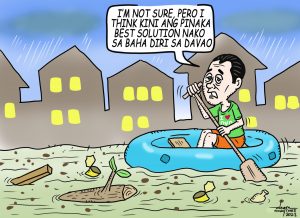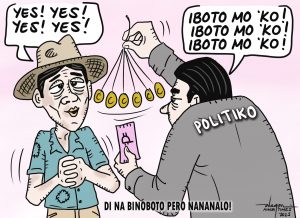I have always thought of Davao as being fiercely independent. It has this “unconquerable” quality that insists on doing its own way. It does not rely on external help and just does everything by itself without whining about it.
This independent spirit is not so much about being against another power that is trying to subdue it but more about being relatively isolated from the rest of the Philippines yet connected to the rest of the world at the same time.
So I have always felt that there are Davaoeños who have this low-key sense of “we were never effectively colonized so we could not really relate to what we are celebrating during Philippine Independence Day every June 12th.”
Multi-awarded writer, historian and educator Macario “Mac” D. Tiu pointed out that “it was only after the conquest of Davao by the Basque Spaniard Jose Oyanguren in 1848 that Davao would have a written history of its own.”
During the 1600s and 1700s, Davao Gulf remained free of colonial control. Some local historians would point out that Davao then was thickly forested so there were no literal paths that would make it easy for people to conquer the area. In other words, we’re isolated and unexplored.
Mac noted that Spanish rule in Davao was “very unstable as the native inhabitants, both the Lumads and the Moros, resisted Spanish efforts to resettle them and make them pay tribute.”
So after 50 years of occupation, the Spaniards abandoned Davao in 1899, and the Americans took over.
Davao did not have to violently kick the Spanish colonizers out in a revolution, they just gave up.
The Americans were more successful in crushing native resistance by using coercion, corruption, and capitalism. American soldiers were amazed at our fertile soil and called Davao the “garden of the gods.” The Americans transformed Davao into huge abaca and coconut plantations.
Mac wrote that Davao then was the “most Americanized town in the country.” And the Americans wanted to make Mindanao into a “white man’s country” the same way they made Hawaii.
It was quite surprising for me to learn from Mac’s book that when Filipino nationalists agitated for independence, “the Americans in Mindanao also demanded the creation of a Moro territory that would detach Mindanao from the rest of the Philippines.”
Imagine that. Americans were part of the secessionist movement in Mindanao. We could have been a state of the United States like Hawaii. I wonder if they have already abandoned that cause or if they are just changing their strategies.
This little known fact of Davao history would probably help explain why we were never part of the national narrative on the struggle for Philippine independence. Why the Katipunan did not have an organized chapter in Davao and why we did not have national heroes who came from here.
As our Davao history would show, it was a different struggle for us. We did not experience the Philippine Revolution led by Andres Bonifacio the same way the rest of the country did.
History professor and author of the “Abaca Forntier,” Patricia Irene “Pat” Dacudao, noted that Davao’s past “was considered uninteresting from a purely national-colonial standpoint, if published works are used as a barometer.”
We are “uninteresting” in the sense that we did not have dramatic episodes that might be considered movie-worthy like “Gomburza,” “Heneral Luna,” and “Sakay.”
“Being a Philippine frontier during the period of American colonial rule significantly links Davao history to broader world narratives beyond its national boundaries,” Pat wrote.
After reading “Abaca Frontier,” one can conclude that it was abaca that made Davao what it is today. It defined the settlement history and development of the Davao region. It shaped the character of Davaoeños as “pioneers” and “innovators” and “multicultural” global citizens.
“Davao was established due to various forces both structural and personal in their nature. On the one hand, there were systems and processes of the global economy and imperialism, and on the other hand, the settlement experience which was the result of thousands of individuals of different ethnicities making their own personal decisions on migration, livelihood, and everyday practices,” explained Pat.
She added that residents of Davao in the first half of the 20th century led not only bicultural but also multicultural lives.
“They participated in the Hispanic, American, and Japanese cultures while living the meaning of their own Filipino lives, sometimes separately, but increasingly creating in the process a new synthesis,” she shared, describing the phenomenon as “cultural hybridity.”
Davao then as it is now is a “contact zone” where “people and their institutions and traditions come together, creating distinctive ways of organizing space and transforming the seemingly fixed edges of empire and nations into fluid spaces.”
Davao’s multicultural vibe and fluidity seem to be a challenge for our Manila-based national government and that is why all throughout our nation’s history, there exists a perennial attempt by Manila to control Davao.
Davaoeños call it “Manila imperialism” but I think Davao is so diverse and ever-changing (because it seeks to always adapt to whatever context or situation, a trait of a pioneer and innovator) that it cannot be effectively conquered by any one entity.
Independence may be in our DNA as frontier people but cooperation — the ability to work and live together as a diverse community — is the secret to our growth and development.
That is why we love to be left alone in peace to do our own thing. Because we have figured out how and if it is something new, we will figure out a way to do it together. It is when outsiders try to impose upon us things that will create divisions among us when chaos arise.
And I believe that is what Davaoeños celebrate on Philippine Independence Day — our ability to create fluid spaces for diverse communities and to find distinctive ways to live together in peace.


